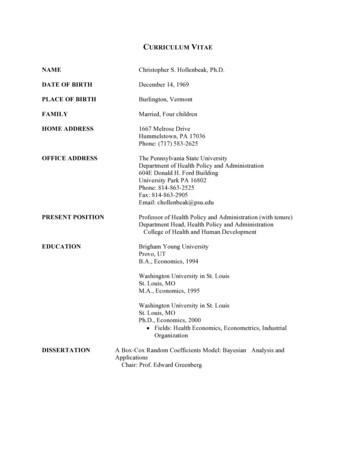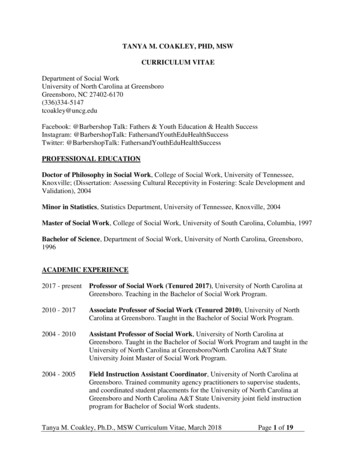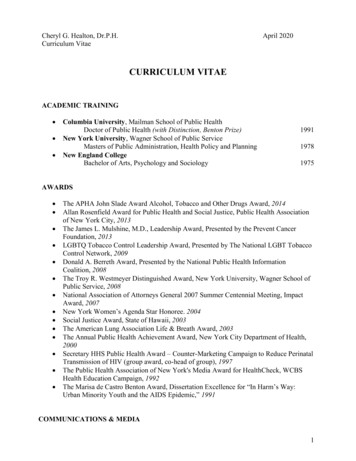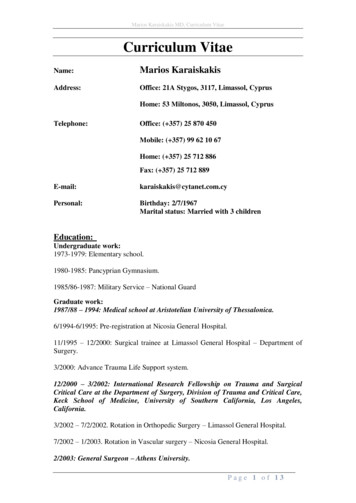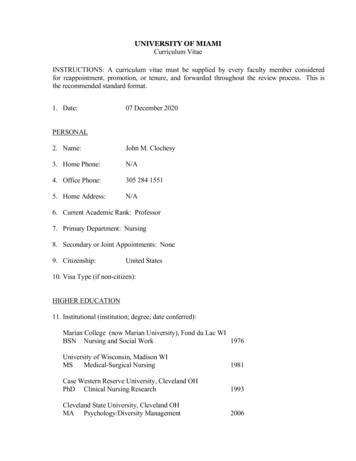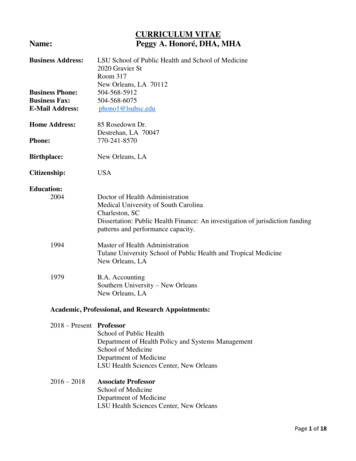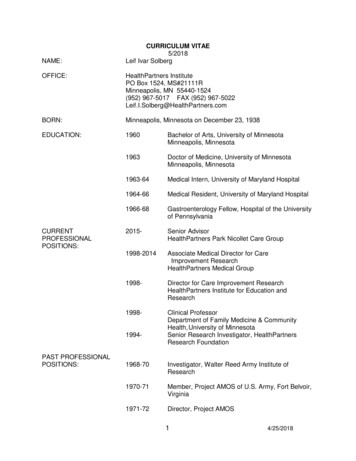
Transcription
NAME:CURRICULUM VITAE5/2018Leif Ivar SolbergOFFICE:HealthPartners InstitutePO Box 1524, MS#21111RMinneapolis, MN 55440-1524(952) 967-5017 FAX (952) eapolis, Minnesota on December 23, 1938EDUCATION:1960Bachelor of Arts, University of MinnesotaMinneapolis, Minnesota1963Doctor of Medicine, University of MinnesotaMinneapolis, Minnesota1963-64Medical Intern, University of Maryland Hospital1964-66Medical Resident, University of Maryland Hospital1966-68Gastroenterology Fellow, Hospital of the Universityof Pennsylvania2015-Senior AdvisorHealthPartners Park Nicollet Care Group1998-2014Associate Medical Director for CareImprovement ResearchHealthPartners Medical Group1998-Director for Care Improvement ResearchHealthPartners Institute for Education andResearch1998-Clinical ProfessorDepartment of Family Medicine & CommunityHealth, University of MinnesotaSenior Research Investigator, HealthPartnersResearch FoundationCURRENTPROFESSIONALPOSITIONS:1994-PAST PROFESSIONALPOSITIONS:1968-70Investigator, Walter Reed Army Institute ofResearch1970-71Member, Project AMOS of U.S. Army, Fort Belvoir,Virginia1971-72Director, Project AMOS14/25/2018
OTHER PASTPOSITIONS:1972-73Private Practice, Kensington, Maryland1973-74Instructor, Department of Community Medicine,Georgetown University, Washington, D.C.1974-87Assistant Professor, Department of Family Practiceand Community Health, Medical School, Universityof Minnesota1987-89Associate Professor, Department of FamilyPractice and Community Health, Medical School,University of Minnesota1983-92Associate Medical Director for QualityImprovement, Blue Plus/BCBSM(Full-time 1990-92)1984-94Editor, Family Practice Research Journal1967-68Medical Advisor, Burlington CountyCommunity Action Program1970-72Medical Advisor, Blackman's Development CenterDrug Cure Program, Washington, D.C.1981-84Associate Editor, Family Practice Research Journal1987Visiting Professor, Universidad Autonoma deGuadalajara, Guadalajara, Mexico1989Visiting Professor, Municipal Health Department,Barcelona, Spain (3 months)2000Visiting Professor, Dept. of Family Med,University of Missouri-ColumbiaACTIVITIES AND RESPONSIBILITIES:National Expert Panels- US Preventive Services Task Force Technical Expert Panel- Online Expert Panel for Defining Continuous QualityImprovement (CQI) in Health Care- National Action Alliance for Suicide Prevention Research TaskForce – Expert- Expert Panel for AHRQ Integration Quality Measures member(for primary/specialty mental health care)- Medicare Health Outcomes Survey Patient ReportedOutcomes Technical Expert Panel24/25/2018
-Health Research and Educational Trust (HRET), TechnicalExpert Panel for the AHRQ-funded Culture, Value, andEfficiency studyReviewer for JAMA, Inquiry, Jt Comm J QualSafety, Ann Fam Med, Ann Int Med, Qual Safety HealthCare, Am J Pub Health, Med Care, Mayo Clin Proc, TobControl, Prev Med, Am J Prev Med, Am J Man Care, Inter JQual Improv, J Am Bd Fam Pract, Nic Tob Research, J GenInt Med, BMJ, New Eng J Med, JAMA Int Med, Gen HospPsych, BMC Med, BMC FP, Milbank Quarterly, Pediatrics, JBehavioral Med, BMJ Qual & Safety, Can Med Assoc J, DiabCare, Inquiry, Academic Pediatrics, J Rural Health Care, JWomen’s Health, and LancetPeer-Reviewed Journal Positions- Associate Editor, Family Practice- Editorial Board, Implementation Science (BioMedCentral)Institute for Clinical Systems Improvement- Alternate member, Board of Directors- Member, Preventive Services CommitteeHealthPartners Institute- Co-lead, Research Strategy CouncilHealthPartners- Senior AdvisorMinn. Academy of Family Physicians- MAFP Foundation – member, Board of DirectorsMN Community Measurement- Health Care Home technical Advisory work Group –memberMN Department of Health- Health Care Home Performance MeasurementCommittee – memberMN Shared Decision-Making Collaborative- Steering Committee – memberMental Health Research Network- Steering Committee – member- Dissemination and Implementation Special InterestGroup – co-leader- Partner organization integration - leaderMidwest Research Network- Mental Health Interest Group – co-chairHONORS:3B.A., Summa Cum LaudePhi Beta KappaAlpha Omega AlphaArmy Commendation Medal4/25/2018
1989 Minnesota Department of Health Award for OutstandingAchievement in Health Promotion Programming - to DoctorsHelping Smokers1995 Researcher of the Year Award - HealthPartners1997 Physician Research Recognition fromMinnesota Physician Publishing, Inc.2001 HealthPartners Medical Group Excellence in ResearchAward2004 Minnesota Academy of Family Physicians (MAFP)Researcher of the Year Award2005 HealthPartners Institute for Education and ResearchFounders Award2008 University of Minnesota Medical Alumni SocietyDistinguished Alumni Award2015 Maurice Wood Award for Lifetime Contribuion to PrimaryCare Research from the North American Primary CareResearch Group (NAPCRG)2017 Member, National Academy of MedicineLICENSURE:BOARDS:MinnesotaDiplomate of American Board of Family Practice (1976-2010)MEMBERSHIPS:Hennepin County and Minnesota Academy of Family PhysiciansAmerican Academy of Family PhysiciansNorth American Primary Care Research GroupAcademy for Healthcare ImprovementSociety for Implementation Research CollaborationSPECIAL INTERESTS:Quality ImprovementImplementation and organizational changeHealth promotion/disease prevention, especially tobaccocessationChronic disease managementIntegrating research and practiceGuidelines and performance measurementFUNDED RESEARCH:PROMOTE: PROMs Optimization through Technology and Engagement. Funded by AHRQ for 1,921,280 over five years to study the implementation and impacts of patient-reportedoutcome measures in joint replacement and spinal surgery patients. Principal investigator 2017.UNITED: Understanding Infrastructure Transformation Effects on Diabetes. Funded by PCORIfor 3.1 million over 5 years to study diabetes quality factors in all Minnesota primary careclinics. Co-Investigator, site lead (Peterson and Carlin Co-PIs, Univ. of Minn.) - 201644/25/2018
ESCALATES. Evaluation of AHRQ Initiative to Accelerate the Dissemination andImplementation of PCOR Findings into Primary Care Practice. Funded by AHRQ for 13,488,000 ( 1.18 million to HealthPartners) over 4 years. Co-Investigator and lead ofDissemination and Engagement (Deb Cohen, OHSU – PI) - 2015SPIRIT: Study to Promote Innovation in Rural Telepsychiatry. Funded by PCORI for 11,776,000 over 5 years to compare integrated versus referral care for complex psychiatricdisorders in rural FQHCs. Co-Investigator. (John Fortney, U Wash PI) - 2015Partnership for Dose: Optimizing Radiation Dosage from CT Exams Clinical Trial. Funded byNIH for 6.2 million over 5 years. Co-Investigator and lead for implementation evaluation(Rebecca Smith-Bindman at UCSF – PI). 2014Mental Health Research Network II. Funded by NIMH for 9.7 million over 5 years. CoInvestigator and lead for health system engagement. (Greg Simon at Group Health – PI) - 2014COMPASS: Care Management of Mental and Physical Comorbidities: A Triple Aim Bullseye.Innovation award from CMS for 18 million over 3 years. Evaluation Director (Sanne Magnan atICSI – PI) - 2012PIONEER: Measuring Patient Outcomes from High Tech Diagnostic Imaging Studies.Fundedfor 672,000 over 2 years by PCORI. PI - 2012Appropriateness and Results of Advanced Diagnostic Imaging Orders for Patients withAbdominal Pain: A Pilot Study. Funded as internal grant by HealthPartners Institute. PI - 2011TransforMN: Evaluating Statewide Transformation of Primary Care to Medical Homes. Fundedby AHRQ for 596,000 over 3 years by AHRQ. PI – 2010.Understanding the Transformation Experience of Small Practices with NCQA’s Medical Homes.Co-PI (Sarah Hudson Scholle, PhD - PI) - 2010AHRQ Task Order: Assessing the Impact of the Patient-Centered Medical Home (PCMH).Funded for 92,000 over 18 months. PI - 2008Pilot Study of High Tech Diagnostic Imaging Decision Support. Funded for 25,000 over 1 yearby HealthPartners Institute for Education and Research as internal grant. PI – 2007DIAMOND STUDY: Evaluation of a Natural Experiment to Improve Statewide Depression Carein Minnesota. Funded for 3.0 million over 5 years by the National Institute of MentalHealth/NIH/DHHS. PI – 2007Retail Clinics: Disruptive Innovation or Just Plain Disruption? Funded for 21,000 over 1 year bythe California Health Care Foundation. PI - 2007Integrated Delivery Systems and Quality Of Care. Funded for 94,000 over 1 year by theCouncil of Accountable Physician Practices (CAPP). PI – 200654/25/2018
Using Public Accountability Measures to Improve Quality of Care. Funded for 25,000 over 1year by HealthPartners Institute for Education and Research as internal grant. Co-Investigator(Patrick O’Connor, MD – PI) - 2006Shared Decision Making: Informed Choice for Uterine Fibroids Treatment Decisions. Funded for 80,500 over 2 years by the Foundation for Informed Decision Making. PI – 2006Assessment of Disparities in Tobacco Use and Treatment. Funded for 115,000 over 2 yearsby ClearWay Minnesota (Formerly MPAAT). PI – 2006Developing Instruments for Decision Quality Measurement. Funded for 25,000 over 1 year byHealthPartners Institute for Education and Research as internal grant. Co-Investigator PI 2006Pilot Study for Comparison of Geriatric Care Team vs. Usual Care Delivery of Medical Servicesfor Residents in Assisted Living Settings. Funded for 25,000 over 1 year by HealthPartnersInstitute for Education and Research as internal grant. Co-Investigator (Robin Whitebird, PhD –PI) – 2005Pilot Study of the Significance of Patient Reports of Medical Errors. Funded for 22,000 over18 months by HealthPartners Institute for Education and Research as internal grant. PI – 2004Tobacco Use and Cessation Among Young Adult Enrollees of a Large Managed CareOrganization. Funded for 278,000 over 2 years by the Minnesota Partnership for ActionAgainst Tobacco (MPAAT). Co-Investigator (Maribet McCarty, PhD, RN – PI) – 2004Testing Incentives & Systems Improvement Collaboratives for Depression Care: Funded for 300,000 over 3 years by RWJ Foundation. PI – 2004Testing the Practice Systems Assessment Survey for Evaluating the Chronic Care Model inPractice (PSAS Phase I). Funded for 288,000 by RWJ over 15 months for collaborativestudies with NCQA. Co-PI (Greg Pawlson at NCQA – PI) – 2003 and 2004Practice Systems Assessment Survey External Validation (PSAS Phase II). Funded for 400,000 by RWJ over 24 months for collaborative studies with NCQA. Co-PI (Greg Pawlsonat NCQA – PI) – 2003 and 2004Priorities Among Recommended Clinical Preventive Services: Phase II; funded for 225,000over 3 years by CDC. Co-Investigator (Michael Maciosek, PhD – PI) – 2002Developing Data to Monitor and Reduce Emergency Department Overcrowding; funded for 186,000 over 11 months by an AHRQ task order. Co-Investigator (Brent Asplin, MD – PI) –2002Helping Prepared Smokers (Project HELP); funded for 500,000 over 3 years by the RobertWood Johnson Foundation ATMC Program. Co-Investigator (Raymond Boyle, PhD – P.I.) –2001Relationship of Provider Group Characteristics to Quality of Care and Medication Errors inAmbulatory Care Setting (Patient Safety Task Order) – Medgroups Project; funded for64/25/2018
140,000 over 18 months by an AHRQ task order. Local PI (Floyd Frost at Lovelace ResearchInstitute – overall PI) – 2002CHronic disease and Access changes Need Good Evaluation (CHANGE); funded for 500,000over 4 years by The Robert Wood Johnson Foundation ICIC Program. PI – 2001HMOs Investigating Tobacco (HIT); funded for 950,000 over 4 years by NCI through theCancer Research Network (CRN) - Co-Principal Investigator (Vic Stevens, PhD – P.I.) – 1999Towards Reducing Cervical and Late Stage Breast Cancer (DETECT); funded for 1.5 millionover 3 years by NCI through the Cancer Research Network (CRN) – Co-Investigator (StephenTaplin, MD, MPH – P.I.) – 1999BHCAG Initiative Evaluation Project; funded for 25,000 over 18 months by The Robert WoodJohnson Foundation through the University of Minnesota – Co-Investigator (Jon B.Christianson, PhD, P.I.) – 1999Tobacco Coverage Study; funded for 500,000 over 26 months by the Robert Wood JohnsonFoundation ATMC Program. Co-Investigator (R. G. Boyle, PhD - P.I.) – 1999Organizational Characteristics and Chronic Disease Care (QUEST); funded for 1.2 million over3 years through the Agency for Research & Quality – Co-Investigator (Patrick J. O’Connor, MD,MPH - P.I.) – 1999Guideline Implementation Study (GUIDO); funded for 75,000 over 1 year by ICSI - PrincipalInvestigator - 1998Depression is a Manageable Disorder (DIAMOND): A Demonstration and Evaluation Project;funded for 298,682 over 2 years by The John D. and Catherine T. MacArthur Foundation Principal Investigator - 1998Improving Diabetes Care through Empowerment, Active Collaboration and Leadership (IDEAL);funded for 2.7 million over 5 years by the Centers for Disease Control and Prevention - CoInvestigator (D. Bishop, Ph.D. - P.I.) - 1994Improving Disease Prevention in Primary Care (IMPROVE); funded for 3.8 million over 4 yearsby the Agency for Health Care Policy and Research - Principal Investigator – 1993, Grant#HS08091Health Education and Research Trial (HEART); funded for 3.5 million over 5 years by NHLBI.Co-Principal Investigator (P. McBride, M.D. - P.I.) – 1992, Grant #HL47554Smoking Cessation Strategies for Minorities; funded for 750,000 over 3 years by NHLBI - CoInvestigator (K. Johnson, MPH - P.I.) – 1989, Grant #HL47554-01A1A Physician-based Nutrition Program to Lower CHD Risk; funded for 2.2 million over 5 yearsby NIH (NHLBI) - Co-Investigator (D. Hunninghake, M.D. - P.I.) – 1986, Grant #HL36889New Patient Survey; funded for 2,039 by Family Health Foundation of America - PrincipalInvestigator – 198474/25/2018
Smoking Cessation in Physicians’ Offices; funded for 1.5 million over 5 years by NIH (NCI) Co-Principal Investigator (T. Kottke, M.D. - P.I.) – 1984, Grant #CA38361Establishment of a Statewide Practitioner-Based Research Network; funded by a 3,900 grantfrom AAFP - Principal Investigator – 1983BIBLIOGRAPHYREFEREED JOURNAL ARTICLES1.Solberg LI, Brooks FP. Cholinergic control of rabbit pancreatic secretion. Am J Dig Dis1969;14:782-787.2.Powell DW, Plotkin GR, Solberg LI, Catlin DH, Maenza RM, Formal SB. Intestinal waterand electrolyte transport in rat salmonella enterocolitis. Gastroenterology 1971;60:10531064.3.Powell DW, Plotkin GR, Solberg LI, Catlin DH, Maenza RM, Formal SB. Experimentaldiarrhea II: Glucose stimulated sodium and water transport in rat salmonella enterocolitis.Gastroenterology 1971;60:1065-1075.4.Powell DW, Plotkin GR, Solberg LI, Catlin DH, Maenza RM, Formal SB. Experimentaldiarrhea III: bicarbonate transport in rat salmonella enterocolitis. Gastroenterology1971;60:1976-1986.5.Sobczyk R, Braunstein ML, Solberg LI, Schuman SH. A case control survey anddysmenorrhea in a family practice population: a proposed disability index. J Fam Pract1978;7:285-290.6.Solberg LI, Johnson JM. The office nurse - a neglected but valuable ally. Fam Pract ResJ 1982;2(2):132-141.7.Mayer TR, Solberg LI, Seifert MH, Cole PM. After-hours telephone calls in the privatefamily practice. J Fam Pract 1983;17:327-332.8.Mayer TR, Solberg LI, Seifert MH, Cole PM. Family practice after-hours telephone use. JAmbulatory Care Manage 1983;6:14-19.9.Solberg LI, Mayer TR, Seifert MH, Cole PM. The Minnesota Academy of FamilyPhysicians Research Panel: a model for collaborative practicing family physicianresearch. Fam Med 1983;15(4):139-142.10.Solberg LI. Defining your practice for research - is there a denominator problem? FamPract Res J 1984;4(1):54-61.11.Solberg LI. Lassitude - a primary care evaluation. JAMA 1984;251(24):3272-3276. (Alsoselected by the Italian, French, and Flemish editions.)84/25/2018
12.Solberg LI, Mayer TR, Seifert MH, Cole PM, Holloway RL. Office telephone calls in familypractice. J Fam Pract 1984;18(4):609-616.13.Solberg LI, Potter AC, Flexner WA. Market research in medical practice: a case study ofone practice’s site survey. Postgrad Med 1985;77(4):317-327.14.Solberg LI, Cole PM, Seifert MH Jr. The Minnesota Academy of Family PhysiciansResearch Network - a vehicle for practice-based research. Minn Med 1986;69:599-601.15.Solberg LI, Solberg JE. Questionnaire instructions - does anybody read them? Fam Med1986;18(2):78-80.16.Kottke TE, Blackburn H, Brekke ML, Solberg LI. The systematic practice of preventivecardiology. Am J Cardiol 1987;59:690-694.17.Peterson MC, Holloway RL, Solberg LI. Assessment by patients of their health educationneeds. Fam Pract Res J 1987;6:158-164.18.Venters MH, Solberg LI, Kottke TE, Brekke ML, Pechacek TF, Grimm RH Jr. Smokingpatterns among social contacts of smokers, ex-smokers, and never-smokers: DoctorsHelping Smokers Study. Prev Med 1987;16:626-635.19.Kottke TE, Solberg LI, Maxwell PL. Smoking cessation strategies and evaluation. J AmColl Cardiol 1988;12:1105-1110.20.Solberg LI, Kottke TE. Doctors helping smokers: a new way to intervene. Minn Med1988;71:413-414,441.21.Kottke TE, Brekke ML, Solberg LI, Hughes JR. A randomized trial to increase smokinginterventions by physicians: Doctors Helping Smokers, Round I. JAMA1989;261(14):2101-2106.22.Solberg LI, Nesvacil LJ, Stoller JE. Patient education by a family nurse as a model fortraining residents. Fam Pract 1989;6(2):114-119.23.Council on Scientific Affairs, AMA. Education for Health: A role for physicians and theefficacy of health education efforts. JAMA 1990;263(13):1816-1819.24.Kottke TE, Solberg LI, Brekke ML. Beyond efficacy testing: introducing preventivecardiology into primary care. Am J Prev Med 1990;6(suppl 1):77-83.25.Kottke TE, Solberg LI, Brekke ML. Initiation and maintenance of patient behavioralchange: What is the role of the physician? J Gen Intern Med 1990;5(suppl):562-567.26.Kottke TE, Solberg LI, Brekke ML, Maxwell PL. Smoking cessation intervention strategiesfor the clinician. Qual Life Cardiovasc Care 1990, Fall;86-93.27.Kottke TE, Solberg LI, Conn SA, Maxwell PL, et al. A comparison of two methods torecruit physicians to deliver smoking cessation interventions. Arch Intern Med1990;150:1477-1481.94/25/2018
28.Nebot M, Solberg LI. Una intervencion integral sobre el tabaquismo en atencion primaria:el Proyecto de ayuda a los fumadores (The helping smokers project: an integratedintervention in primary care). Atencion Primaria 1990;7:698-702.29.Solberg LI, Maxwell PL, Kottke TE, Gepner GH, Brekke ML. A systematic primary careoffice-based smoking cessation program. J Fam Pract 1990;30:647-654.30.Venters MH, Kottke TE, Solberg LI, Brekke ML, Rooney B. Dependency, social factors,and the smoking cessation process: Doctors Helping Smokers Study. Am J Prev Med1990;6:185-193.31.Ballestin M, Solberg LI. Tabaquismo: una intervencion integral. Rev Rol de Enfermeria1991;151:21-26.32.Kottke TE, Solberg LI. Incorporating smoking interventions into medical practice: takingthe next step. (Editorial) J Gen Intern Med 1991;6:94-95.33.Solberg LI, Peterson KE, Ellis RW, et al. The Minnesota project: a focused approach toambulatory quality assurance. Inquiry 1991;27:359-367.34.Stanford JB, Solberg LI. Rural patients’ interests in preventive medical care. J Am BoardFam Pract 1991;4(1):11-17.35.Kottke TE, Solberg LI, Brekke ML, Conn SA, Maxwell PM, Brekke MA. A controlled trial tointegrate routine smoking cessation advice into primary care practice: Doctors HelpingSmokers, Round III. J Fam Pract 1992;34:701-708.36.Lando HA, Johnson KM, McGovern PG, Graham-Tomas RP, Solberg LI. Urban Indians’Smoking patterns and interest in quitting. Public Health Rep 1992;107:340-344.37.Parkinson MD, Schauffler HH, Kottke TE, Curry SJ, Solberg LI, et al. Report of theTobacco Policy Research Study Group on reimbursement and insurance in the UnitedStates. Tob Control 1992;1:S52-S56.38.Folsom AR, Johnson KM, Lando HA, McGovern PG, Solberg LI, Ekstrum JK. Plasmafibrinogen and other cardiovascular risk factors in urban American Indian smokers. EthnDis 1993;3:344-350.39.Kottke TE, Brekke ML, Solberg LI. Making “time” for preventive services. Mayo ClinicProc 1993;68:785-791.40.Kottke TE, Solberg LI, Knapp JM. Community and clinical strategies for tobacco control.Cardiovasc Risk Factors 1993, July;3(4):4-12.41.Solberg LI. Implementing smoking cessation in daily practice. Cardiovasc Risk Factors1993, July;13-15.42.Kottke TE, Mantak FJ, Solberg LI. Youth addiction to tobacco: involving physicians andchanging community norms. Minn Med 1994;77(12):28-31.104/25/2018
43.Kottke TE, Wilms DG, Solberg LI, Brekke ML. Physician-delivered smoking cessationadvice: issues identified during ethnographic interviews. Tob Control 1994;3:46-49.44.Kottke TE, Solberg LI. Is it not time to make smoking a vital sign? Mayo Clinic Proc1995;70:303-304.45.Kottke TE, Solberg LI. Nicotine patches: a doubtful key to tobacco control? (Editorial) JNatl Cancer Inst 1995;87(2):71-72.46.Kottke TE, Solberg LI, Brekke ML. Health plans helping smokers. HMO Pract1995;9(3):128-133.47.Solberg LI, Isham GJ, Kottke TE, Magnan S, Nelson AF, Reed MK, Richards S.Competing HMOs collaborate to improve preventive services. Jt Comm J Qual Improv1995;21(11)November:600-610.48.McBride PE, Massoth K, Underbakke G, Solberg LI, Beasley JW, Plane MB. Recruitmentof private practices for primary care research: experiences in a preventive servicesclinical trial. J Fam Pract 1996;43(4)October:389-395.49.O’Connor PJ, Solberg LI, Christianson JB, Amundson GH, Mosser G. Mechanism ofaction and impact of a cystitis clinical practice guideline on outcomes and costs of care inan HMO. Jt Comm J Qual Improv 1996;22(10):673-82.50.Solberg LI. Practical implications of recall bias. (Editorial) Tob Control 1996;5(2):95-96.51.Solberg LI, Kottke TE, Brekke ML, Calomeni CA, Conn SA, Davidson G. UsingContinuous Quality Improvement to increase preventive services in clinical practice—going beyond guidelines. Prev Med 1996;25(3)May/June:259-267.52.Johnson KM, Lando HA, Schmid LA, Solberg LI. The GAINS project: outcome ofsmoking cessation strategies in four urban Native American clinics. Addict Behav1997;22(2):207-218.53.Kottke TE, Solberg LI, Brekke ML, Cabrera A, Marquez M. Will patient satisfaction set thepreventive services implementation agenda? Am J Prev Med 1997;13(4):309-316.54.McBride PE, Plane MB, Underbakke G, Brown RL, Solberg LI. Smoking screening andmanagement in primary care practices. Arch Fam Med 1997;6, March/April:165-172.55.Solberg, LI. Tobacco use prevention and cessation. Postgrad Med 1997;101(3),March:292-302.56.Solberg LI, Mosser G, McDonald SF. The three faces of performance measurement:improvement, accountability, and research. Jt Comm J Qual Improv1997;23(3)March:135-147.57.Solberg LI, Brekke ML, Kottke TE. How important are clinician and nurse attitudes to thedelivery of clinical preventive services? J Fam Pract 1997;44(5)May:451-461.114/25/2018
58.Solberg LI, Brekke ML, Kottke TE. Are physicians less likely to recommend preventiveservices to low SES patients? Prev Med 1997;26(3), May/June:350-357.59.Kottke TE, Solberg LI, Brekke ML, Cabrera A, Marquez M. Delivery rates for preventiveservices in 44 midwestern clinics. Mayo Clinic Proc 1997;72(June):515-523.60.Fischer LR, Solberg LI, Kottke TE, Calomeni CA. A process IMPROVEment approach topreventive services: case studies of CQI demonstration projects in two primary careclinics. HMO Pract 1997;11(3)September:123-129.61.Magnan S, Solberg LI, Giles KS, Kottke TE, Wheeler JW. Primary care, processimprovement, and turmoil. J Ambulatory Care Manage 1997;20(4)October:32-38.62.Solberg LI, Reger LA, Pearson TL, Cherney LM, O’Connor PJ, Freeman SL, Lasch SL,Bishop DB. Using continuous quality improvement to improve diabetes care inpopulations: the IDEAL model. Jt Comm J Qual Improv 1997;23(11)November:581-592.63.Solberg LI, Kottke TE, Conn SA, Brekke ML, Calomeni, Conboy KS. Delivering clinicalpreventive services is a systems problem. Ann Behav Med 1997;19(3):271-278.64.Nelson AF, Quiter ES, Solberg LI. The state of research within managed care plans: 1997survey. Health Affairs 1998;17(1)Jan./Feb.:128-138.65.Solberg LI, Brekke ML, Kottke TE, Steel RP. CQI in primary care: what’s happening?Med Care 1998;36(5):625-635.66.Solberg LI, Kottke TE, Brekke ML. Will primary care clinics organize themselves toimprove the delivery of preventive services? A randomized controlled trial. Prev Med1998;27(4):623-31.67.Fischer LR, Solberg LI, Kottke TE. Quality improvement in primary care clinics. Jt CommJ Qual Improve 1998;24(7)July:361-70.68.O’Connor PJ, Solberg LI, Baird MA. The future of primary care. The enhanced primarycare model. J Fam Pract 1998;47(1)July:62-67.69.Solberg LI, Kottke TE, Brekke ML, Conn SA, Magnan S, Amundson GM. The case of themissing clinical preventive services systems. Eff Clin Pract 1998;1(1)Aug/Sept:33-8.70.O’Connor PJ, Desai J, Rush WA, Cherney LM, Solberg LI, Bishop DB. Is having a regularprovider of diabetes care related to intensity of care and glycemic control? J Fam Pract1998:47(4)October;290-7.71.Magnan S, Solberg LI, Kottke TE, Nelson AF, Amundson GM, Richards S, Reed MK.IMPROVE: Bridge over troubled waters. Jt Comm J Qual Improv1998;24(10)October:566-78.72.Solberg LI, Kottke TE. Patient perceptions: an important contributor to how physiciansapproach tobacco cessation. (Editorial) Tob Control 1998:7(4):421-2.124/25/2018
73.Calomeni CA, Solberg LI, Conn SA. Nurses on quality improvement teams: how do theybenefit? J Nurs Care Quality 1999;13(5):75-90.74.Solberg LI. Are model diabetes care programs enough? (Editorial). Models of Care1999;2(1):2.75.Klingner JM, Solberg LI, Knudson-Schumacher S, Huss KL, Carlson RR. How satisfiedare mothers with 1-day hospital stays for routine delivery? Eff Clin Pract 1999;2(6):253-7.76.Solberg LI, Korsen N, Oxman TE, Fischer LR. The need for a system in the care ofdepression. J Fam Pract 1999;48(12):973-9.77.Solberg LI. Bupropion with or without a nicotine patch was more effective than a nicotinepatch alone or placebo in smoking cessation. Evidence-Based Cardiovasc Med1999;3(4):96. Comment on: Jorenby DE, Leischow SJ, Nides MA et al. A controlled trialof sustained-release bupropion, a nicotine patch, or both for smoking cessation. N Engl JMed 1999;340:685-691.78.Braun BL, Fowles JB, Solberg LI, Kind E, Healey M, Anderson R. Patient beliefs aboutthe characteristics, causes, and care of the common cold. J Fam Pract 2000;49(2):153-6.79.McBride P, Underbakke G, Plane MB, Massoth K, Brown RL, Solberg LI, Ellis L, SchrottHG, Smith K, Swanson T, Spencer E, Pfeifer G, Knox A. Improving prevention systems inprimary care practices: the Health Education and Research Trial (HEART). J Fam Pract2000;49(2):115-25.80.Solberg LI. Incentivising, facilitating, and implementing an office tobacco cessationsystem. Tob Control 2000;9(Suppl I):i37-i41.81.Solberg LI, Brekke ML, Fazio CJ, Fowles J, Jacobsen DN, Kottke TE, Mosser G,O’Connor PJ, Ohnsorg KA, Rolnick SJ. Lessons from experienced guidelineimplementers: attend to many factors and use multiple strategies. Jt Comm J QualImprov 2000;26(4):171-88.82.Kottke TE, Solberg LI, Brekke ML, Magnan S, Amundson GM. Clinician satisfaction witha preventive services implementation trial: the IMPROVE project. Am J Prev Med2000;18(3):219-24.83.Solberg LI, Kottke TE, Brekke, ML, Magnan S, Davidson G, Calomeni CA, Conn SA,Amundson GM, Nelson AF. Failure of a trial of a continuous quality intervention toincrease the delivery of clinical preventive services. A randomized trial. Eff Clin Pract2000;3(3)105-15.84.Solberg LI, Kottke TE, Brekke ML, Magnan S. Improving prevention is difficult.Commentary. Eff Clin Pract 2000;3(3):153-5.85.Solberg LI. Guideline implementation: what the literature doesn’t tell us. Jt Comm J QualImprov 2000;26(9):525-37.134/25/2018
86.Solberg LI, Braun, BL, Fowles JB, Kind EA, Anderson RS, Healey ML. Care-seekingbehavior for upper respiratory infections. J Fam Pract 2000;49(10):915-20.87.Solberg LI, Boyle RG, Davidson G, Magnan SJ, Carlson CL. Patient satisfaction anddiscussion of smoking cessation during clinical visits. Mayo Clin Proc 2001;76:138-43.88.Solberg LI, Kottke TE, Brekke ML. Variation in clinical preventive services. Eff Clin Pract2001:4(3):121-6.89.Kottke TE, Solberg LI. STEP(ing)-UP to deliver clinical preventive services. Am J PrevMed 2001;21(1):68-9.90.Solberg LI, Boyle RG, Davidson G, Magnan S, Carlson CR, Alesci NL. Aids to quittingtobacco use: how important are they outside controlled trials? Prev Med 2001;33(1):53-8.91.Fischer LR, Solberg LI, Zander KM. The failure of a controlled trial to improve depressioncare: a qualitative study. Jt Comm J Qual Improv 2001;27(12):639-650.92.Solberg LI, Fischer LR, Wei F, Rush WA, Conboy KS, Davis TF, Heinrich RL. A CQIintervention to change the care of depression: a controlled study. Eff Clin Pract2001;4(6):239-249.93.Glasgow RE, Orleans CT, Wagner EH, Curry SJ, Solberg LI. Does the chronic caremodel serve also as a template for improving prevention? Milbank Q 2001:79(4):579-612.94.Lyles A, Weiner JP, Shore AD, Christianson J, Solberg LI, and Drury P. Cost and qualitytrends in direct contracting arrangements. Health Aff 2002;21(1):89-102.95.Solberg LI, Plane MB, Brown RL, Underbakke G, McBride PE. Non-response bias: doesit affect measurement of clinician behavior? Med Care 2002;40(4):347-352.96.Solberg LI. Guideline implementation: why don’t we do it? Editorial. Am Fam Physician2002;65(2):176,181-2.97.Solberg LI, Lyles CA, Shore AD, Lemke KW, Weiner JP. Is quality free? The relationshipbetween cost and quality across 18 provider groups. Am J Manag Care 2002;8(5):41322.98.Rigotti NA, Quinn VP, Stevens VJ, Solberg LI, Hollis JF, Rosenthal AC, Zapka JG, FranceE, Gordon N, Smith S, Monroe M. Tobacco-control policies in 11 leading managed careorganizations: Progress and challenges. Eff Clin Pract 2002;5(3):130-136.99.Solberg L
PROFESSIONAL HealthPartners Park Nicollet Care Group POSITIONS: 1998-2014 Associate Medical Director for Care . Council of Accountable Physician Practices (CAPP). PI - 2006 . Tobacco Use and Cessation Among Young Adult Enrollees of a Large Managed Care Organization. Funded for 278,000 over 2 years by the Minnesota Partnership for Action .
